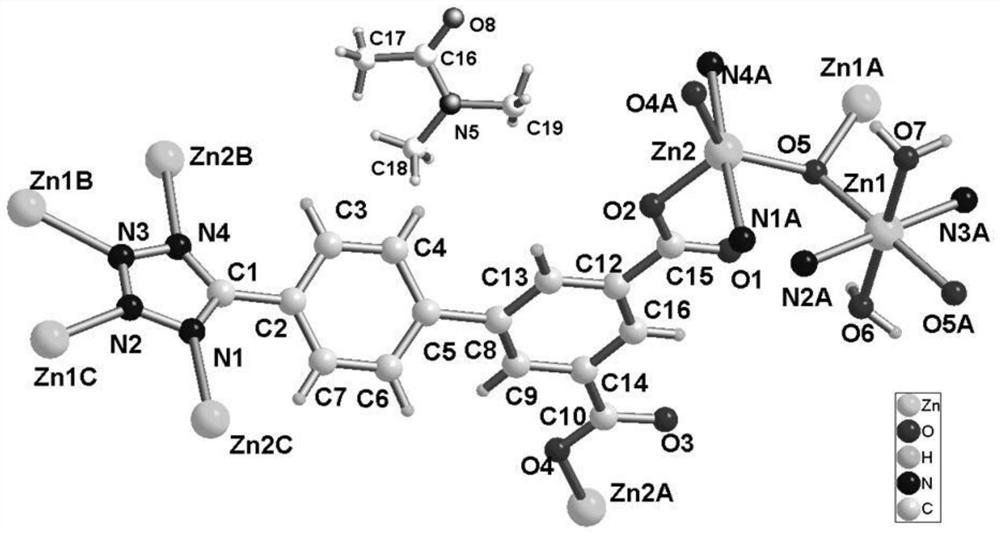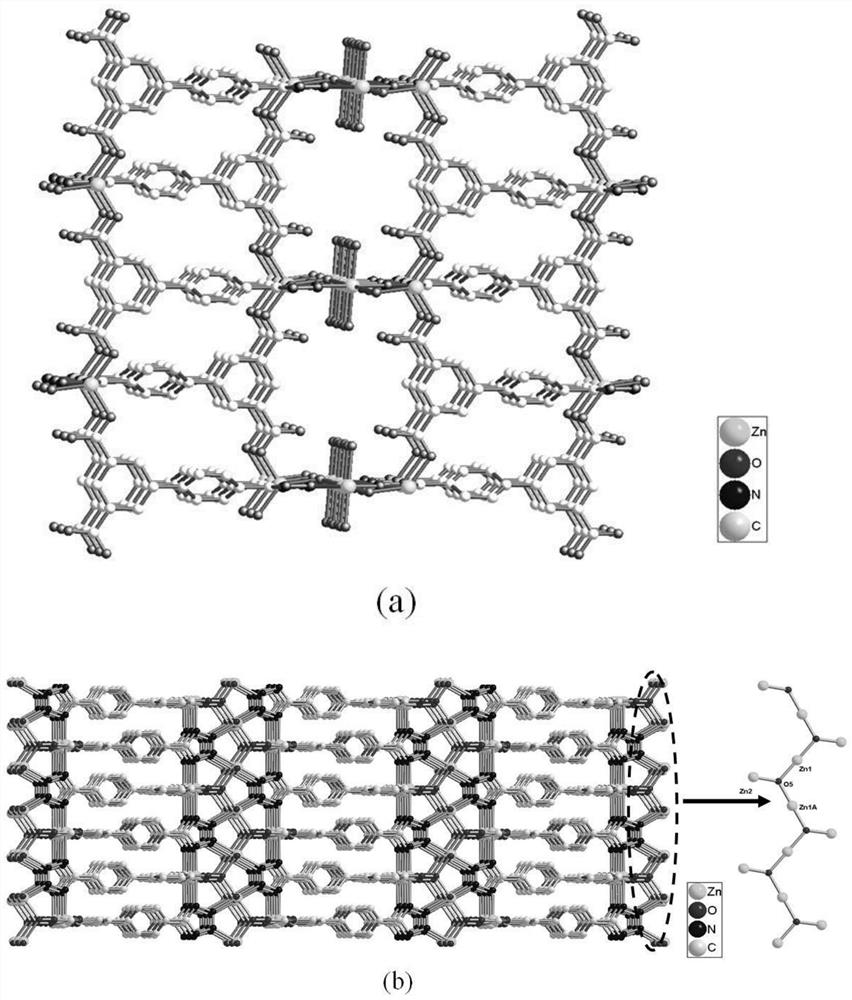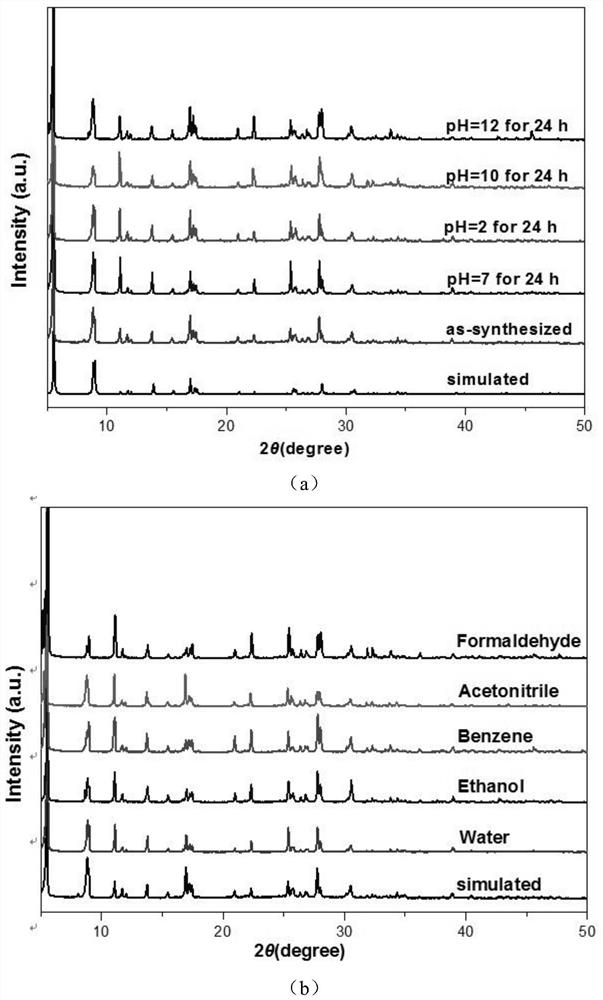An ultra-stable three-dimensional luminescent zinc(ii) metal-organic framework material and its preparation method and application
A metal-organic framework, three-dimensional technology, which is applied in the field of ultra-stable three-dimensional luminescent zinc metal-organic framework materials and their preparation, can solve problems such as environmental pollution and affect public health, and achieves a visual detection process, good application value, and simple operation. Effect
- Summary
- Abstract
- Description
- Claims
- Application Information
AI Technical Summary
Problems solved by technology
Method used
Image
Examples
Embodiment 1
[0039] Example 1—Synthesis and Characterization of Ultrastable Three-Dimensional (3D) Luminescent Zn(II) Metal Organic Frameworks
[0040] 89.3mg, 0.3mmol of Zn(NO 3 ) 2 ·6H 2 O, 129.9mg, 0.3mmol of La(NO 3 ) 3 ·6H 2 A mixture of O and 31.0 mg, 0.1 mmol of 4'-(1-hydrogen-tetrazole-5)-biphenyl-3,5-dicarboxylic acid was stirred in 2 mL of deionized water and 4 mL of DMAC for 0.5 hours. Subsequently, the resulting solution was transferred to a stainless steel autoclave with a polytetrafluoroethylene liner, heated at 120°C for 96 hours, and cooled to 25°C after 48 hours of cooling to obtain colorless block crystals. Washed several times with deionized water and ether. Based on ligand H 3 Yield of L: 36%. Elemental analysis calculated value (%) C 18 h 17.75 N 4.75 o 7.75 Zn 2 : C 38.93, H 3.22, N 11.98; actual sample element measurement value (%): C 39.16, H 3.46, N 12.15; indicating that the element composition is basically consistent with the theoretical value.
[0...
Embodiment 2
[0047] Example 2—Selective detection of nicotinamide based on metal-organic framework materials as fluorescent probes
[0048] For the MOF prepared in Example 1, we measured the photoluminescence properties of the free organic ligand (Compound L) in aqueous solution at ambient temperature. The free organic ligand exhibits an emission peak at λ=376nm when the excitation wavelength is 272nm. Compared with the photoluminescence peak of organic ligands, a strong photoluminescence peak of MOFs can be observed at λ=365nm, therefore, the emission peaks of MOFs should be attributed to the fluorescence emission within ligands. Compared with the emission peaks of organic ligands, the effective enhancement of the emission peaks of MOFs can be attributed to the coordination of the organic ligands to the Zn center, which further enhances the conformational rigidity of the organic ligands and lowers the excited state (π -π*) nonradiative decay. The photoluminescence peak intensity of the ...
Embodiment 3
[0053] Example 3—Selective detection of tetraphenylboron anions based on metal organic framework materials as fluorescent probes
[0054] Among numerous anions, tetraphenylboron anion is one of the most important and critical ions in biological systems, especially in the human brain. In fact, changes in the homeostasis of tetraphenylborate anion in cells may lead to some copper metabolism disorders (such as Wilson's disease) and neurodegenerative diseases (such as Alzheimer's disease). Therefore, real-time, convenient and intuitive detection of trace amounts of tetraphenylborate anion is very important, which helps to provide clues for the treatment of diseases or for the treatment of diseases. The desire to detect tetraphenylborate anion both qualitatively and quantitatively is considered to be of great importance, considering the increased risks associated with tetraphenylborate anion to human health.
[0055] In our work, due to the excellent visible blue light when excite...
PUM
 Login to View More
Login to View More Abstract
Description
Claims
Application Information
 Login to View More
Login to View More - R&D
- Intellectual Property
- Life Sciences
- Materials
- Tech Scout
- Unparalleled Data Quality
- Higher Quality Content
- 60% Fewer Hallucinations
Browse by: Latest US Patents, China's latest patents, Technical Efficacy Thesaurus, Application Domain, Technology Topic, Popular Technical Reports.
© 2025 PatSnap. All rights reserved.Legal|Privacy policy|Modern Slavery Act Transparency Statement|Sitemap|About US| Contact US: help@patsnap.com



